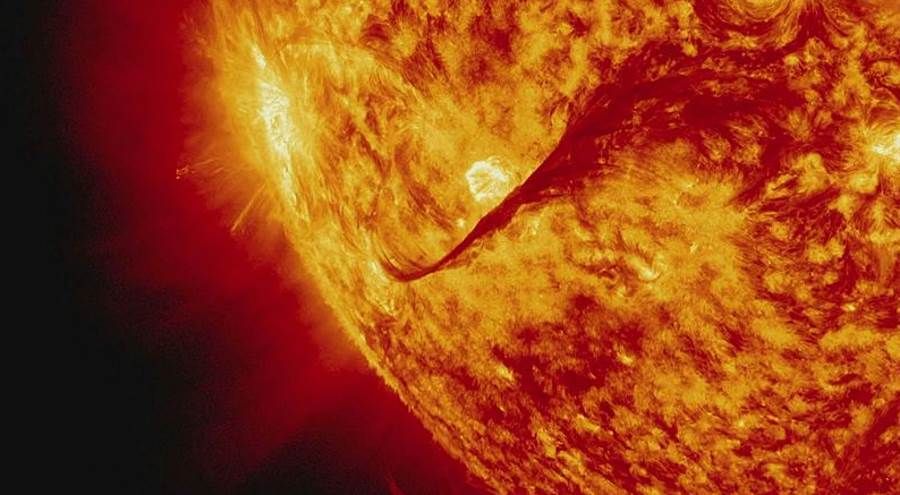Why the Sun's corona is hotter than its surface?
Why the temperature in the Sun's corona is several million degrees higher than on the star's surface? Research with the participation of Poles shows that this phenomenon is partly due to a specific type of waves ejecting matter from a star – the so-called. pseudo-shock waves.
It would seem that the further we are from the source of the The warmer it gets, the colder it gets. In the case of our most important source However, it is not so at all. – The Sun hides many mysteries – one of them is the temperature – m In an interview with the Polish Press Agency, Prof. Wi Wi spoke about the method. Krzysztof Murawski from Maria Curie-Skłodowska University in Lublin, who ry pr b is trying to solve this riddle.
The surface of the sun – the photosphere, that part of a star that It shines – it has almost 5.7 thousand. degrees Kelvin (about 5.5 thousand. degrees Celsius). As we begin to move away from the Sun's surface, the temperature of the atmosphere actually drops politely. And at an altitude of 600 km from the sun it is already by almost p One and a half thousand degrees cooler (4300 degrees K). But as we move further away from the Sun's surface, the temperature starts to rise again. And to insanely high temperatures. Temperature in the solar corona, a few thousand. km above the surface and can reach up to 2 million degrees K. For several decades this huge r he temperature difference between the surface of the Sun and its corona puzzles a scientist .
Astronomers They are trying to discover where the heat in the upper layers of the Sun's atmosphere comes from. Now in "Nature Astronomy" A publication has been issued, which and this partly explains the problem.
Scientists – in a study led by Prof. Abhishek Srivastava – have shown that with the increase in temperatures in the solar corona is related to a specific type of waves formed in the matter on the surface of the Sun – the so-called. pseudo-sclerosis. – We have shown that pseudowaves have the potential to heat the solar corona – says prof. Murawski.
Heliophysicist explains that a pseudoshock is something like a shock wave (also called a shock wave), but not quite. And a shock wave is a characteristic disturbance that re being created e.g. during the flight of a supersonic plane, the explosion of an atomic bomb, or. of whip cracking. As prof. Murawski, in a wave of such matter in a way b discontinuous changes some of its very important parameters in: speed, pressure and density.
However physicists know also another kind of waves, which shock waves are very similar to shock waves, but the matter in them behaves a little differently. It is the so-called. Pseudo-shockwave. – In a pseudoshock in the way b discontinuous only the density changes. So it's a bit of a cheated shockwave," says prof. Murawski. He gives the example that a pseudo-shock wave appears in a tsunami. And when we direct a small stream of running water onto a plate, the pseudo-shock wave can be seen at the edge of the oval formed by the water.
The same kinds of waves can be observed in matter, from which the stars are built. Shock waves have been known on the Sun for a long time. But pseudo-shock waves have been discovered there only now. – It is enough to have a source The lack of energy, which ra will force the plasma to move at supersonic speeds and a shock wave will be produced. And right behind it follows the pseudo-shock wave – describes prof. Murawski.
For a layperson such a r tion of shockwaves and pseudo-shockwaves does not matter too much. But it rises to prominence when you prepare simulations, numerical models of the sun's atmosphere. And the scientists from the Maria Curie-Skłodowska University have one of the most accurate models in the world to simulate the atmosphere of our star.
This model was prepared by Dariusz W as part of his master's thesis jcik from UMCS. When in the numerical code Pole effects associated with the occurrence of pseudo-shock in the atmosphere, it began to be seen where the heat comes from in the g The solar atmospheric.
But pseudo-shock waves are not enough to heat up a star's corona. Last year, the team prof. Murawski pom he point out another factor that contributes to the hot solar corona – the so-called "pseudorenewal". Alfv waveséat. It is known, however, that this is not all – there are still holes in the models. – We are very close to solving the hot corona problem. And it seems to me that our next article will solve this riddle to the very end," smiles Prof. Kramer mysteriously. Murawski. And he adds that work on this article is already in progress.
